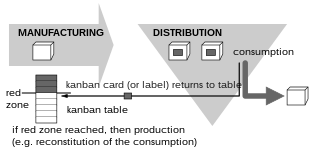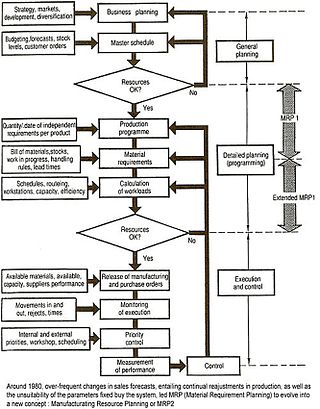Related Research Articles
Material requirements planning (MRP) is a production planning, scheduling, and inventory control system used to manage manufacturing processes. Most MRP systems are software-based, but it is possible to conduct MRP by hand as well.

Inventory or stock refers to the goods and materials that a business holds for the ultimate goal of resale, production or utilisation.
Logistics engineering is a field of engineering dedicated to the scientific organization of the purchase, transport, storage, distribution, and warehousing of materials and finished goods. Logistics engineering is a complex science that considers trade-offs in component/system design, repair capability, training, spares inventory, demand history, storage and distribution points, transportation methods, etc., to ensure the "thing" is where it's needed, when it's needed, and operating the way it's needed all at an acceptable cost.

Kanban is a scheduling system for lean manufacturing. Taiichi Ohno, an industrial engineer at Toyota, developed kanban to improve manufacturing efficiency. The system takes its name from the cards that track production within a factory. Kanban is also known as the Toyota nameplate system in the automotive industry.
Vendor-managed inventory (VMI) is an inventory management practice in which a supplier of goods, usually the manufacturer, is responsible for optimizing the inventory held by a distributor.

Manufacturingresource planning is a method for the effective planning of all resources of a manufacturing company. Ideally, it addresses operational planning in units, financial planning, and has a simulation capability to answer "what-if" questions and is an extension of closed-loop MRP.

Distribution software refers to software which manages everything from order processing and inventory control to accounting, purchasing and customer service, supply chain management, sales, customer relationship management, and finance management.
A warehouse management system (WMS) is a set of policies and processes intended to organise the work of a warehouse or distribution centre, and ensure that such a facility can operate efficiently and meet its objectives.

Operations management is concerned with designing and controlling the production of goods or services, ensuring that businesses are efficient in using resources to meet customer requirements.
Safety stock is a term used by logisticians to describe a level of extra stock that is maintained to mitigate risk of stockouts caused by uncertainties in supply and demand. Adequate safety stock levels permit business operations to proceed according to their plans. Safety stock is held when uncertainty exists in demand, supply, or manufacturing yield, and serves as an insurance against stockouts.

The business terms push and pull originated in logistics and supply chain management, but are also widely used in marketing and in the hotel distribution business.
The term demand chain has been used in a business and management context as contrasting terminology alongside, or in place of, "supply chain". Madhani suggests that the demand chain "comprises all the demand processes necessary to understand, create, and stimulate customer demand". Cranfield School of Management academic Martin Christopher has suggested that "ideally the supply chain should become a demand chain", explaining that ideally all product logistics and processing should occur "in response to a known customer requirement".

The bullwhip effect is a supply chain phenomenon where orders to suppliers tend to have a larger variability than sales to buyers, which results in an amplified demand variability upstream. In part, this results in increasing swings in inventory in response to shifts in consumer demand as one moves further up the supply chain. The concept first appeared in Jay Forrester's Industrial Dynamics (1961) and thus it is also known as the Forrester effect. It has been described as "the observed propensity for material orders to be more variable than demand signals and for this variability to increase the further upstream a company is in a supply chain". Research at Stanford University helped incorporate the concept into supply chain vernacular using a story about Volvo. Suffering a glut in green cars, sales and marketing developed a program to sell the excess inventory. While successful in generating the desired market pull, manufacturing did not know about the promotional plans. Instead, they read the increase in sales as an indication of growing demand for green cars and ramped up production.
Supply-chain optimization (SCO) aims to ensure the optimal operation of a manufacturing and distribution supply chain. This includes the optimal placement of inventory within the supply chain, minimizing operating costs including manufacturing costs, transportation costs, and distribution costs. Optimization often involves the application of mathematical modelling techniques using computer software. It is often considered to be part of supply chain engineering, although the latter is mainly focused on mathematical modelling approaches, whereas supply chain optimization can also be undertaken using qualitative, management based approaches.
Field inventory management, commonly known as inventory management is the function of understanding the stock mix of a company and the different demands on that stock. The demands are influenced by both external and internal factors and are balanced by the creation of purchase order requests to keep supplies at a reasonable or prescribed level. Inventory management is important for every other business enterprise.
Customer demand planning (CDP) is a business-planning process that enables sales teams to develop demand forecasts as input to service-planning processes, production, inventory planning and revenue planning.
Channel coordination aims at improving supply chain performance by aligning the plans and the objectives of individual enterprises. It usually focuses on inventory management and ordering decisions in distributed inter-company settings. Channel coordination models may involve multi-echelon inventory theory, multiple decision makers, asymmetric information, as well as recent paradigms of manufacturing, such as mass customization, short product life-cycles, outsourcing and delayed differentiation. The theoretical foundations of the coordination are based chiefly on the contract theory. The problem of channel coordination was first modeled and analyzed by Anantasubramania Kumar in 1992.
Petrolsoft Corporation (1989–2000) was a supply chain management software company with a focus on the petroleum industry. Petrolsoft Corporation was founded at Stanford University in 1989 by Bill Miller and David Gamboa as Petrolsoft Software Group. It was later incorporated in 1992. Petrolsoft introduced demand-driven inventory management to the petroleum industry.
Inventory management software is a software system for tracking inventory levels, orders, sales and deliveries. It can also be used in the manufacturing industry to create a work order, bill of materials and other production-related documents. Companies use inventory management software to avoid product overstock and outages. It is a tool for organizing inventory data that before was generally stored in hard-copy form or in spreadsheets.
Inventory optimization is a method of balancing capital investment constraints or objectives and service-level goals over a large assortment of stock-keeping units (SKUs) while taking demand and supply volatility into account.
References
- ↑ "stock control". Macmillan Dictionary. Macmillan Publishers Limited. Retrieved 21 June 2018.
- 1 2 3 4 Schwarz, Lisa (18 September 2018). "Essential Guide to Inventory Control".
- ↑ Lewis, C. (2012). "Chapter 1: Demand forecasting and inventory control". Demand Forecasting and Inventory Control. Routledge. p. 3–20. ISBN 9781136346835.
- ↑ Axsäter, S. (2015). "Chapter 1: Introduction". Inventory Control. Springer. p. 1–6. ISBN 9783319157290.
- ↑ Axsäter, S. (2015). "Chapter 2: Forecasting". Inventory Control. Springer. p. 7–35. ISBN 9783319157290.
- ↑ Hayes, R. (2014). Retail Security and Loss Prevention. Butterworth-Heinemann. p. 30. ISBN 9781483296005.
- ↑ Wesley, R.L.; Wanat, J.A. (2016). A Guide to Internal Loss Prevention. Elsevier. pp. 81–3. ISBN 9781483135731.
- ↑ Chorafas, D.N., ed. (1965). "Chapter 13: Specifications for Inventory Control". Systems and Simulation. Mathematics in Science and Engineering. Vol. 14. Elsevier. pp. 233–52. doi:10.1016/S0076-5392(09)60019-9. ISBN 9780123749185.
- 1 2 3 Axsäter, S. (2015). "Chapter 11: Implementation". Inventory Control. Springer. p. 223–34. ISBN 9783319157290.
- 1 2 3 4 Wild, R. (2002). Essentials of Operations Management. Cengage Learning. pp. 332–3. ISBN 9781844800520.
- ↑ Azadivar, F.; Rangarajan, A. (2016). "10.6 Inventory Management in Practice". In Ravindran, A.R. (ed.). Operations Research and Management Science Handbook. CRC Press. pp. 10-34–10-35. ISBN 9781420009712.
- 1 2 Donath, B.; Mazel, J.; Dubin, C.; Patterson, P., eds. (2002). "Part II Inventory Management - Chapter 4: Software and Technology". The IOMA Handbook of Logistics and Inventory Management. John Wiley & Sons. pp. 504–38. ISBN 9780471209355.
- ↑ Gulati, R.; Smith, R. (2009). Maintenance and Reliability Best Practices. Industrial Press, Inc. pp. 122–4. ISBN 9780831133115.
- ↑ Pantano, E.; Nguyen, B.; Dennis, C.; et al. (2017). Internet Retailing and Future Perspectives. Routledge. p. PT301. ISBN 9781317378761.
- 1 2 3 4 5 Dopson, L.R.; Hayes, D.K. (2015). Food and Beverage Cost Control. John Wiley & Sons. pp. 115–17. ISBN 9781118988497.
- ↑ Waller, M.A.; Esper, T.L. (2014). The Definitive Guide to Inventory Management: Principles and Strategies for the Efficient Flow of Inventory Across the Supply Chain. Pearson Education. pp. 150–1. ISBN 9780133448825.
- ↑ "How to Control Inventory Stock Levels?". SeeBiz. 2021-06-21. Retrieved 2022-05-13.